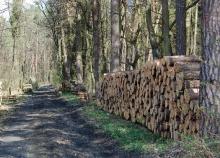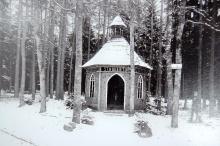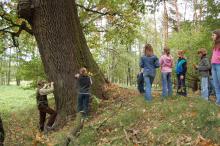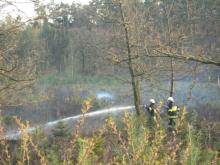 Wydawca treści
Wydawca treści
Wstęp - tekst
Las jest wspólnym dobrem, a każdy zaobserwowany tutaj detal jest połączony także ze mną i prowadzi mnie do odkrywania kolejnej fascynującej informacji o świecie
Wędrówka po ścieżce może być okazją do tego, aby zrozumieć, że las jest wartością.
Nie tylko na poziomie przyjemnych doświadczeń wędrówki i odpoczynku czy dostarczyciela zasobów, ale również na poziomie uniwersalnym jako ekosystem, niezależnie od naszej w nim obecności. Aby wędrówka wzdłuż tej ścieżki wzbudziła takie refleksje w odbiorcach, doświadczenia, które go spotkają, muszą być dla niego ważne i dotykać jego aparatu pojęciowego. Ta myśl jest również istotna z punktu widzenia zarządcy terenu, bo włącza ona w proces docenienia tego miejsca coraz szersze grono ludzi.
Aby wędrówka nie była bezrefleksyjna, tylko przekładała się na konkretne poczucie, że wnosi ona jakąś wartość dla użytkowników, postanowiono rozszerzyć doświadczenia zwykłej obserwacji przyrody. Wykorzystano do tego świadomość, ze w danym momencie na ścieżce jesteśmy "tu i teraz" i możemy być uczestnikami konkretnych wydarzeń w życiu lasu, natomiast one dzieją się niezależnie od naszej obecności.
To jak jeden kadr z życia lasu, a przecież całość składa się z nieskończonej ilości takich kadrów. Większości z nich jednak nie widzimy i ta niewiedza, kiedy ją sobie uświadomimy, może być przytłaczająca, ale także zachęcająca do wykorzystania tego czasu, kiedy jesteśmy w lesie.
Również każdy detal przestrzeni przyrodniczej, to jego "tu i teraz". Widzimy go
w określonym miejscu i czasie, często nie zdając sobie sprawy, że jest on połączony skomplikowaną siecią zależności z setkami innych elementów.
Jakie może to mieć znaczenie dla człowieka, który nie jest leśnikiem ani przyrodnikiem? Na końcu ścieżki wędrujący zrozumie, że on także jest częścią tej sieci. Że nie jest tylko obserwatorem lasu, jak turysta na wycieczce,
ale uczestnikiem zależnym od tego, co go otacza.
Ta myśl może zmieniać perspektywę patrzenia na las i zachęcać do większej uważności w jego poznawaniu czy doświadczaniu. To odniesienie do wartości uniwersalnych, które nie pozostawiają ludzi obojętnymi.
Słowa - klucze
- Trwałość (docenienie trwałości ekosystemu leśnego, jego stabilności i dynamicznej równowagi. W kontraście do tej trwałości stoi krótki moment, w którym obserwujemy przyrodę uchwyconą niejako
w jednym kadrze. Trwałość jest połączeniem tych kadrów, z których widzimy tylko jeden lub zaledwie kilka).
- Wiedza (odkrycie, ze każdy element lasu jest połączony z inny siecią zależności oraz że uważna obserwacja może pomóc odkryć wiedzę o świecie przyrody, która jest na wyciągnięcie ręki. To jak odkrywanie nieznanych światów, które przecież wcale nie są ukryte).
- Uczestniczenie (zrozumienie, że jesteśmy częścią przyrody i mamy miejsce w tej sieci połączeń nie jako widzowie, ale uczestnicy.
To rodzi odpowiedzialność za wspólne dobro, jakim jest las.
The forest is a common good, and every detail observed here is also connected to me and leads me to discover another fascinating pieceof information about the world
A hike along the trail can be an opportunity to understand that the forest is valuable. Not only as a place for pleasant hiking and resting experiences or as a provider of resources, but also on a universal level as an ecosystem, regardless of our presence in it. In order for a hike along this path to evoke such reflections in the audience, the experiences they encounter must be meaningful to them and touch their conceptual apparatus. This thought is also important from the point of view of the site manager, because it involves an increasingly wide group of people in the process of appreciating this place.
In order for the hike not to be thoughtless, but to translate into a concrete sense that it brings some value to the users, it was decided to extend the experience of ordinary nature observation. This was done with the awareness that at any given moment on the path we are ‘here and now’ and we can be participants in specific events in the life of the forest, while they happen regardless of our presence. It’s like one frame from the life of the forest, and yet the whole consists of an infinite number of such frames. However, we do not see most of them and this lack of knowledge, when we realise it, can be overwhelming, but also encourages us to make the most of our time in the forest.
Every detail of the natural environment is also its ‘here and now’ experience. We see it in a specific place and time, often without realising that it is connected by a complex network of dependencies with hundreds of other elements. What significance can this have for a person who is not a forester or naturalist? At the end of the trail, the hiker will understand that they too are part of this network. That they are not just observers of the forest, like a tourist on a trip, but participants dependent on their surroundings. This thought can change the perspective of looking at the forest and encourage greater attention in getting to know or experiencing it. It is a reference to universal values that do not leave people indifferent.
Key words
Durability (appreciation of the durability of the forest ecosystem, its stability and dynamic balance. In contrast to this durability stands the brief moment in which we observe nature captured, so to speak, in a single frame. Durability is a combination of these frames, of which we can see only one or just a few).
Knowledge (the realisation that every part of the forest is connected to another through a network of interdependencies and that careful observation can help us discover knowledge about the natural world that is right there in front of us. It’s like discovering unknown worlds that are not hidden at all).
Participation (understanding that we are part of nature and that we have a place in this network of interconnections not as spectators but as participants. This entails responsibility for the common good that is the forest).










